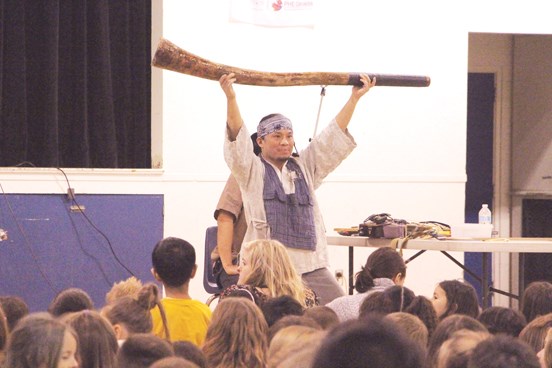Music is everywhere.
The Dumpsta Dragons were in Yorkton to prove it. The duo of Alcvin Ramos and Andrew Kim were at St. Mary’s and Columbia Schools on Sept. 25 as part of an OSAC tour of Saskatchewan classrooms. They brought with them a wide variety of instruments, whether they were traditional or made out of things like hockey sticks and tennis racquets.
The duo met about thirteen years ago at a yoga school, hit it off, and quickly became friends, said Ramos. After drifting in and out of groups together for a number of years, they decided to form a new group called the Dumpsta Dragons.
One of the things that connects them is a love of unconventional instruments.
“I have an affinity to weird instruments, exotic instruments, but cool sounding instruments,” said Ramos.
The main instrument for Ramos is the Shakuhachi, a bamboo flute that has been in Japan since about the 7th century. He has been studying it for 25 years.
“I go to Japan every couple of years to keep the energy going,” Ramos said.
Kim’s start with non-traditional instruments started at a world music festival about ten years ago. He saw some musicians from Africa who were using instruments they built themselves. Inspired, he decided to build instruments himself, but couldn’t get shows with them.
“I started touring schools with homemade instruments... It really took off. So now these old instruments that were sitting in my closet are now my main tools,” said Kim.
Kim’s inspiration comes from everywhere, usually starting from ideas of shapes of parts which could work. He then goes to a hardware store and sees what he can find.
“I usually don’t even know what the hardware bits are used for, but they have the right shape, and I pop them onto the tennis racquet, and it actually works!”
They show kids how to make an instrument out of a spoon and rubber band. Kim notes he’s seen kids try that same trick in the playground after their performance.
The goal is to break down boundaries, and show kids that they can make music no matter what resources they have at their disposal, so long as they’re creative and are willing to try something new.
“If your mind is open, your imagination is wide, you’re a conduit for everything. Music is vibration, everything is vibration. If you learn how to do creatively, you can do it positively and affect the world in a beautiful way,” Ramos said.
The message resonates with kids, as they learn what inspired some traditional sounds, as well as how the noises they make can be turned into music. Turning noises kids make into music is the show’s finale, as volunteers from the audience are invited on stage to improvise a song by adding sounds to a music loop.
“When they see our energy, our openness to creativity, and our noise making, the kids love it,” Ramos said.
Touring the province with OSAC, the duo has been enjoying the opportunity to see the province’s schools.
“We’re so blessed that OSAC invited us here to see the various personalities of each school... Some schools are 45 students, some schools are 600, and everybody has been so great to us, but everybody has a different personality and it’s so fascinating to share our music with everybody,” Ramos said.



